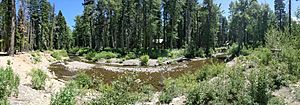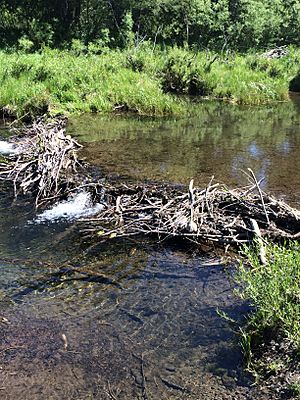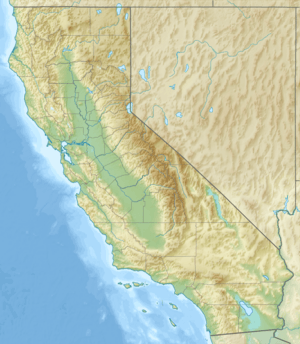Blackwood Creek (California) facts for kids
Quick facts for kids Blackwood Creek |
|
|---|---|

Blackwood Creek, just above California State Route 89
|
|
|
Location of the mouth of Blackwood Creek in California
|
|
| Country | United States |
| State | California |
| Region | Placer County |
| Cities | Tahoe Pines, Idlewild |
| Physical characteristics | |
| Main source | Southwest flank of Ellis Peak in the Sierra Nevada Mountains 8,000 ft (2,400 m) 37°19′12″N 122°09′19″W / 37.32000°N 122.15528°W |
| River mouth | Lake Tahoe Tahoe Pines 6,234 ft (1,900 m) 39°03′47″N 120°12′24″W / 39.06306°N 120.20667°W |
| Basin features | |
| Tributaries |
|
Blackwood Creek (called dogásliʔ by the Washoe people) is a stream in California. It flows eastward for about 8 miles (13 kilometers). The creek starts on the side of Ellis Peak in the Sierra Nevada Mountains. It then flows into Lake Tahoe about 4.2 miles (6.8 kilometers) south of Tahoe City, California. You can find Blackwood Creek between the small towns of Idlewild and Tahoe Pines in Placer County, California.
The Story of Blackwood Creek
Blackwood Creek got its name from an early settler named Hampton Craig Blackwood. He was a miner and fisherman who settled near where the creek meets Lake Tahoe in 1866.
For many years, until the 1970s, the land around the creek was used for grazing animals and cutting down trees. There's even a place called "Blackwood Pass" near the creek's source. This pass was named on an old map from 1876.
What is a Watershed?
A watershed is an area of land where all the water drains into a single stream, river, or lake. Blackwood Creek is a very important watershed for Lake Tahoe. It is the third largest stream that flows into Lake Tahoe.
The Blackwood Creek watershed covers a large area of about 7,166 acres (2,900 hectares). The main creek has two smaller streams that flow into it: the Middle Fork Blackwood Creek and the North Fork Blackwood Creek. A road called Barker Pass Road runs alongside the main creek.
Animals and Nature
Blackwood Creek has always been important for fish. Long ago, native Lahontan cutthroat trout lived here. These fish were very important to the Washoe people for food.
Today, the creek is a key place for non-native rainbow trout to lay their eggs. These rainbow trout are a popular fish in Lake Tahoe.
Recently, scientists have found that beavers also live in the Sierra Nevada mountains. Beavers build dams, but these dams do not seem to stop trout from moving up and down the creek. In fact, beaver dams can even help protect against wildfires.



